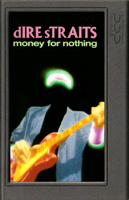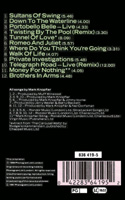Compass Point Studios, Nassau, Bahamas, 28th November 1978 - 22nd December 1978 [6]
Power Station, New York USA, New York, USA, 20th June 1980 - 25th August 1980 [5, 11]
Power Station, New York, USA, 8th March 1982 - 11th June 1982 [8]
Jam Studios, London UK, 1st October 1982 - 3rd October 1982 [4]
Live in concert, unknown location, June 1983 [3]
Hammersmith Odeon, London, UK, 23rd July 1983 [9]
Air Studios, Montserrat, West Indies, 2nd November 1984 - 21st December 1984 and 3rd January 1985 - 6th February 1985 [7, 10, 12]
- Sultans of swing
- Down to the waterline
- Portobello belle (live)
- Twisting by the pool (remix)
- Romeo and Juliet
- Where do you think you're going?
- Walk of life
- Private investigations
- Telegraph road (live, remix)
- Money for nothing
- Tunnel of love
- Brothers in arms


Digital Compact Cassette (DCC) is an obsolete magnetic tape sound recording format introduced by Philips and Matsushita in late 1992. Pitched as a successor to the standard analog cassette, and competitor to MiniDisc (MD) and Digital Audio Tape (DAT), it never became popular with the general public. It shared the same form factor as analog cassettes, and DCC recorders could play back either type of cassette. In February 1996, Jan Timmer who was President of Philips at the time, admitted that sales of DCC were below expectations. According to him, it had become a "niche product for audiophiles". Timmer made clear that it would not be kept in production at any price: "We have to make the balance sometime: how much did it cost, what does it bring in and what are we doing with it now". The DCC was discontinued in October 1996 after Philips admitted it had achieved poor sales and MiniDisc was winning.